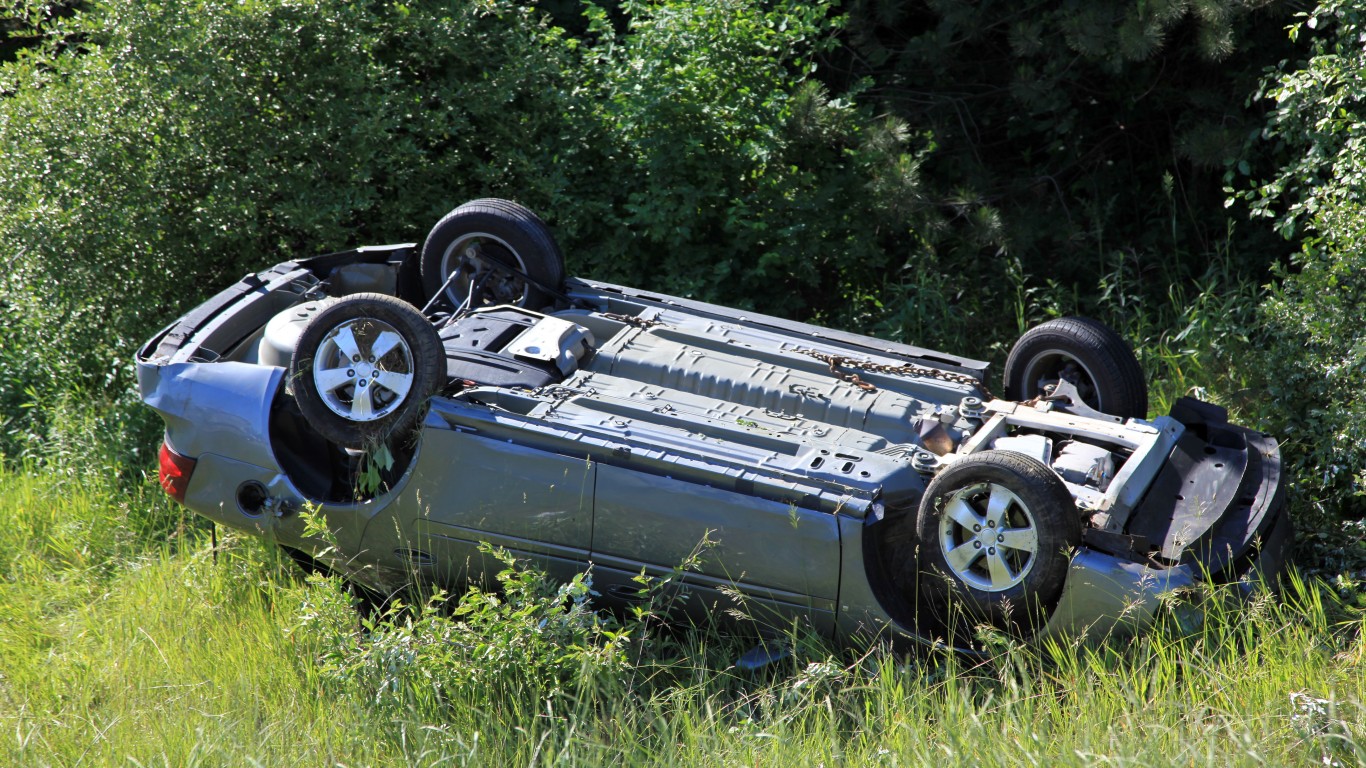Cars and Drivers
These Cars Have the Highest Risk of Being Involved in a Fatal Crash

Published:
Last Updated:

In 2017, more than 37,000 people were killed on U.S. roads and highways. As bad as that sounds, it was nearly 2% lower than the 2016 total. And based on the latest report from the National Highway Traffic Safety Administration (NHTSA), the estimated fatality total for the first half of last year showed a 3% year-over-year drop.
The NHTSA data also includes the fatality rate on U.S. roads per 100 million vehicle miles traveled. In 2017, the rate was 1.12, down slightly from 1.14 in 2016. Since 2007, the lowest rate was posted in 2014 at 1.01. It’s probably no coincidence that 2014 was also the last year when gasoline prices exceeded an average of $3 a gallon for the full year.
Researchers at iSeeCars.com have analyzed fatal crash statistics for the years between 2013 and 2017 and determined fatal accident rates for the more than 25 million used cars sold for those model years (full report is available on the site). That comparison revealed 14 cars that have a fatality rate that is more than double the overall average of 2.6 fatalities per billion miles driven.
iSeeCars.com CEO Phong Ly commented, “Despite recent advances in safety technology, our data suggests that small vehicles still aren’t as safe as larger vehicles when they are involved in serious accidents. Subcompact cars have a fatal accident rate of 4.5 cars per billion vehicle miles, which is almost double the overall average.”
Sports cars, however, posted the highest rates, with an overall rate of 4.6 fatalities per billion miles. Ly noted, “They’re designed to prioritize speed and acceleration, so it is perhaps no surprise that their accidents result in a high number of fatalities.”
The car with the highest fatality rate was the Mitsubishi Mirage, a subcompact available in both hatchback and sedan models that scored well in most tests conducted by the Insurance Institute for Highway Safety (IIHS) with the exception of the small-overlap, driver-side crash. The test simulates a left-front collision with a stationary object like a tree or telephone pole. The Mirage’s fatality rate was 10.2 deaths per billion miles, nearly four times the average rate.
The subcompact Honda Fit ranked third with a fatality rate of 7.7. The other four subcompacts on the list were the Chevrolet Spark (7.2 fatalities, ranked fifth), the Nissan Versa (6.1, eighth), the Kia Rio (5.9, ninth) and the Nissan Versa Note (5.2, 14th).
The Chevrolet Corvette with a fatality rate of 9.8 was second. Other sports cars among the top 14 were the Subaru BRZ (6.9, sixth), the Nissan 370Z (6.2, seventh), Dodge Challenger (5.8, tenth), Chevy Camaro (5.5, 11th) and the Hyundai Veloster Turbo (5.2, 13th).
Two compact cars, the Kia Forte (7.4, fourth) and the Kia Soul (5.3, 12th), also posted fatality rates more than double the average rate.
The sport utility vehicle segment posted the fewest fatalities per billion miles driven with a rate of 1.7. Only two vehicles, the Kia Sportage (3.8) and the Jeep Wrangler (3.6), posted rates more than double for vehicles in the segment. The Lincoln MKT and the Mitsubishi Outlander Sport posted rates of 3.3, while the Buick Encore, Mitsubishi Outlander and Subaru Forester posted rates of 3.2.
Among pickup trucks, the average fatality rate was 2.3 per billion miles. No truck posted a score that was double rate, although the Nissan Frontier scored 3.9, well ahead of the second-ranked Ram 1500 with a score of 2.6. Only one other truck scored above average, the Chevy Silverado 1500 with a score of 2.5.
The Nissan Frontier was one of five trucks to receive only a “marginal” rating on the IIHS small-overlap crash test. The Chevy Silverado 1500 also received a “marginal” rating on the test, while the full-size Nissan Titan and Ford F-150 both received “good” ratings. Car safety is crucial. Motor-vehicle crashes remain a leading cause of death nationwide, and these are the cities where the most people die in car crashes.
The thought of burdening your family with a financial disaster is most Americans’ nightmare. However, recent studies show that over 100 million Americans still don’t have proper life insurance in the event they pass away.
Life insurance can bring peace of mind – ensuring your loved ones are safeguarded against unforeseen expenses and debts. With premiums often lower than expected and a variety of plans tailored to different life stages and health conditions, securing a policy is more accessible than ever.
A quick, no-obligation quote can provide valuable insight into what’s available and what might best suit your family’s needs. Life insurance is a simple step you can take today to help secure peace of mind for your loved ones tomorrow.
Click here to learn how to get a quote in just a few minutes.
Thank you for reading! Have some feedback for us?
Contact the 24/7 Wall St. editorial team.